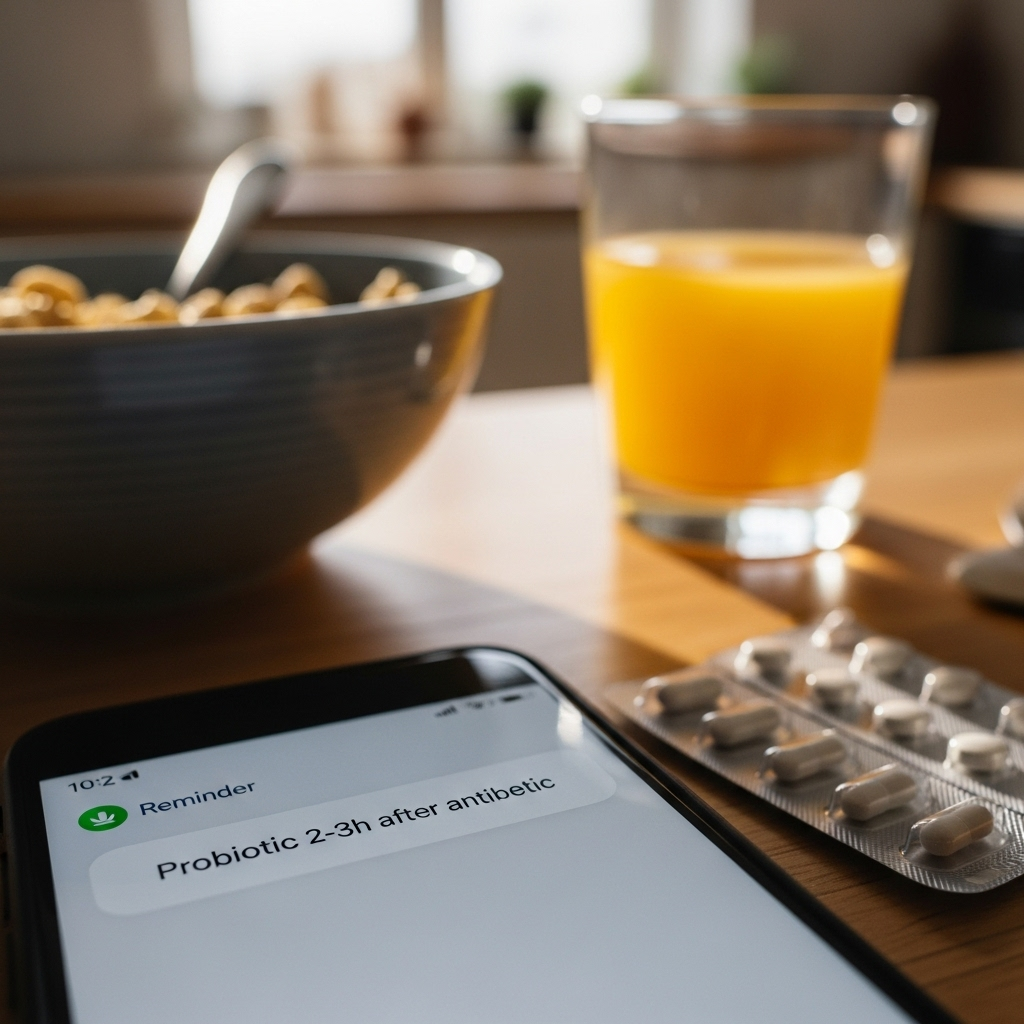How to Space Probiotics When Pets Are on Antibiotics

When your dog or cat needs antibiotics, you may hear that adding a probiotic can help reduce diarrhea and support gut health. That’s often true, but timing matters. Antibiotics can kill the beneficial bacteria in probiotic products, so giving them too close together can reduce the probiotic’s effectiveness. This article explains practical, vet-friendly ways to space probiotics and antibiotics for pets, how long to continue probiotics, product considerations, and safety tips.
Why spacing probiotics and antibiotics matters
Antibiotics are designed to kill or inhibit bacteria. Many probiotic products contain live bacterial strains (for example, Lactobacillus, Bifidobacterium, Enterococcus, Bacillus). If you give a live bacterial probiotic at the same time as an antibiotic, the antibiotic may kill those probiotic organisms before they reach the gut, making the supplement less useful.
Spacing reduces direct exposure of the probiotic organisms to the antibiotic in the stomach and small intestine, increasing the chance that beneficial microbes survive to reach the lower gut where they can support digestion and balance the microbiome.
General timing guidelines for pet owners
Exact timing depends on the antibiotic dosing schedule and the probiotic formulation. Use these simple rules as a starting point and follow your veterinarian’s specific recommendations.
Common practical schedules
- Once-daily antibiotic: Give the probiotic 2–4 hours after the antibiotic dose.
- Twice-daily (BID) antibiotic: Give the probiotic at least 2 hours after each antibiotic dose. If the probiotic is given once daily, give it midway between the two antibiotic doses (about 6 hours after the morning dose for a 12-hour schedule).
- Three times daily (TID): Try to give the probiotic between antibiotic doses (e.g., about 3–4 hours after a dose) or consult your vet for the best spacing strategy.
- Antibiotics given continuously (IV or infusion): Speak with your veterinarian. They may recommend specific probiotics (such as a yeast-based product) or different timing.
Why 2–4 hours?
This window helps reduce direct overlap in the gut. It’s not an exact science because antibiotics have different absorption times and half-lives, but 2–4 hours is a widely used and practical interval recommended by many veterinarians.
Product and strain considerations
Not all probiotics are the same. When choosing a product for your pet, consider:
- Strain-specific effects: Certain strains have more evidence for reducing antibiotic-associated diarrhea (for example, Saccharomyces boulardii is a yeast with evidence in people and veterinary usage).
- Formulation: Chewables, powders, capsules, pastes, and veterinary-specific formulations exist. Some are enteric-coated or contain spore-forming Bacillus strains that survive antibiotics better.
- CFU and label claims: Check colony forming units (CFU) at time of manufacture and storage requirements. Veterinary products include dosing instructions specific to animal weight.
- Yeast-based probiotics: Saccharomyces boulardii is a live yeast and not affected by antibacterial drugs, so it can often be given concurrently with antibiotics. Discuss with your vet first.
How long should you continue probiotics?
Many veterinarians recommend continuing probiotics for the duration of the antibiotic course and for 1–2 weeks after antibiotics stop to help the gut microbiome recover. In cases of severe or recurrent digestive issues, your vet may recommend a longer course (4 weeks or more) or a targeted therapeutic product.
Administration tips for success
- Give probiotics with food unless the product label instructs otherwise. Food can buffer stomach acid and improve survival of probiotics.
- Don’t mix live probiotics into very hot food, which can kill organisms. Allow cooked food to cool slightly before adding.
- Follow weight-based dosing and the manufacturer’s or veterinarian’s directions precisely.
- Store products according to label instructions (some need refrigeration, others are shelf-stable).
- If your pet spits out or refuses a form (e.g., capsule), ask your vet or pharmacist about opening capsules or using a paste/powder alternative.
Safety and special situations
Probiotics are generally safe for healthy dogs and cats, but there are exceptions:
- Pets with severe immune suppression, critical illness, or central lines may have a higher risk of rare probiotic-associated infections. Consult your veterinarian before starting probiotics in these cases.
- Very young puppies or kittens and elderly pets with complex health issues should use probiotics under veterinary supervision.
- Mild side effects like gas or soft stools may occur for a few days as the microbiome adjusts. If symptoms worsen, stop the probiotic and contact your vet.
Monitoring and when to call your veterinarian
Watch for improvements in stool consistency, appetite, and energy. If diarrhea, vomiting, lethargy, bloody stool, or other concerning signs develop or continue despite treatment, contact your veterinarian promptly. They may adjust the antibiotic, recommend a different probiotic, or investigate other causes.
| Pros | Cons |
|---|---|
| Can reduce antibiotic-associated diarrhea and support gut recovery | Antibiotics can kill probiotic strains if given too close together, reducing effectiveness |
| Many safe, easy-to-administer options (powders, chews, pastes) | Not all products are equally effective; strain and dosing matter |
| Yeast-based probiotics (S. boulardii) can often be used concurrently | Rare risk of infection in severely ill or immunocompromised pets |
FAQ
-
Can I give a probiotic at the same time as an antibiotic?
Generally no for bacterial probiotics—give them 2–4 hours apart. A yeast probiotic (Saccharomyces boulardii) is not affected by antibiotics and can often be given at the same time, but check with your vet first.
-
How long after antibiotics should I continue probiotics?
Typically continue for 1–2 weeks after the antibiotic course to help restore the microbiome. Your veterinarian may recommend a longer period for persistent or severe problems.
-
Are human probiotics okay for pets?
Some human products can be used for pets, but veterinary-specific products are formulated and dosed for animals. Always check with your vet before using human probiotics for your pet.
-
What if my pet refuses the probiotic form I bought?
Ask your veterinarian for an alternative form. Many probiotics come in palatable chews, powders, or pastes. Never force a product if it stresses your pet—work with your vet for a better option.
Key Takeaways
- Space bacterial probiotics and antibiotics by about 2–4 hours to improve probiotic survival.
- Saccharomyces boulardii (a yeast) is usually not affected by antibiotics and may be given concurrently with veterinary guidance.
- Continue probiotic use during antibiotics and for 1–2 weeks after; extend if advised by your vet.
- Choose strains and formulations appropriate for your pet and follow veterinarian dosing instructions.
- Contact your veterinarian if your pet is severely ill, immunocompromised, or if symptoms worsen.
Disclaimer: This information is educational and not a substitute for veterinary care. Always follow your veterinarian’s instructions for antibiotics and supplements for your pet. If you have concerns about dosing, interactions, or your pet’s health, consult your veterinarian promptly.

Leave a Reply